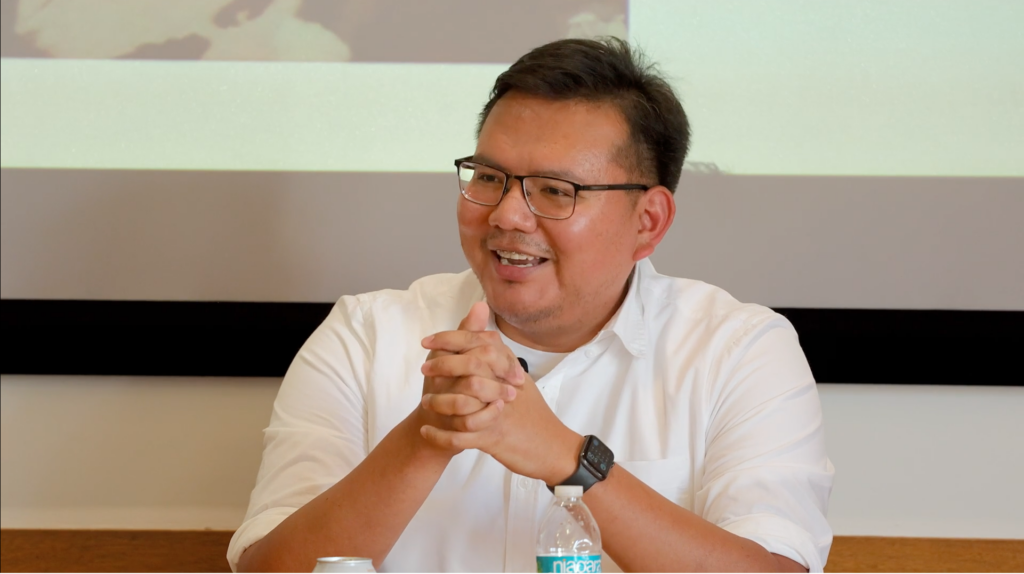by Marisa Lin, October 6, 2022
Fall 2022 Poetry Reading and Craft Talk, held on October 6th 2022 (event info here). The full recording of the event is available for viewing on our YouTube channel, here.

The Land Remembers: The Memory Field by Jake Skeets
“The landscape is associated with memory,” said Jake Skeets in his October craft talk sponsored by the Arts Research Center. “It is the way we perceive the world, how we define a kind of personal truth.” So began The Memory Field, a lecture in which Skeets discussed how land informs how we express—and define—ourselves through memory.
Skeets’ first encounters with the idea of place were influenced by Gallup, New Mexico, a town near his childhood home. In Gallup—center of Old Hollywood, alcohol, and a bustling Native American art trade—glamor and progress situated themselves amidst a patchwork of indigenous communities.
These notions would later find expression in Skeets’ acclaimed poetry collection, Eyes Bottle Dark and a Mouthful of Flowers. They would also guide his exploration of the Memory Field, which he coined as “radical remembering as resistance and reconciliation.”
The Memory Field is both place and form, map and meadow. It describes how the land is an active participant in how we recount the past, perceive the world, and create art. It’s how when walking through the streets of our younger years, we feel our histories peel from the ground, the buildings, the trees, reanimating themselves as if they had been asleep and our steps had awakened them. The land, in helping us remember, becomes a part of ourselves. “Land and memory,” said Skeets, “are one and the same.”
Using a framework by Navajo elder Philmer Bluehouse, Skeets described how memory consists of layers of knowledge, from the basic (riding a bike) to the esoteric (prayers and songs). In Skeets’ words, entering the Memory Field involves “a spiraling of knowledge within ourselves.” Drawing from Brenda Miller’s The Body of Memory, Skeets explains how personal memory is woven from textures of observation and experience that are held in the body. When we create, we automatically tap into our bodies’ ways of knowing, a consciousness that overflows into art, essays, poems.
Indeed, the Memory Field is about how place is folded, and folds us, into the creative process. Sitting in my own memory field is my childhood home in Rochester, Minnesota. Growing up, I was fascinated by the woods at the edge of my family’s backyard, captivated by this exuberant, organic chaos that lay on the other side of our neatly mowed patch of grass. Just last week, when my mother showed me the view from her iPad, the bare, finger-like branches of the bur oaks revived in me whimsical sensations of plucking daddy longlegs from ferns, dodging trees on sleds, and getting lost with the tops of houses still in sight. The line between lawn and woods shaped the psyche of an impressionable young Chinese girl who learned the manners of White society but yearned to journey into the intrepid, unpredictable realm of her inner self. Somewhere along this border, I became a poet.
But it’s not only personal memory we draw from. Skeets also emphasized the importance of postmemory, which Marianne Hirsch defines as “the relationship that the ‘generation after’ bears to the personal, collective, and cultural trauma of those who came before—to experiences they ‘remember’ only by means of the stories, images, and behaviors among which they grew up.” This concept is familiar to indigenous peoples and others who have been marginalized, whose documentation of their histories rests not on paper but in corporate remembrance—one of “imaginative investment, projection, and creation” (Hirsch). Postmemory is a means to re-envision and reclaim that which was stolen without material record. It is, Skeets offered, where decolonization starts.
But where, exactly, do we begin? I might suggest that treating the Memory Field as not just a figurative concept, but a literal place, can call our attention to our geographical location and the policies and systems presiding over us. US land use and zoning policies, for instance, dictate who can live where, do what, and how. The rules of the reservation, where sale of alcohol was prohibited yet still accessible just outside of its boundaries, influenced the setting of Skeets’ childhood. In mine, it was the single-family zoned suburbs and the notion of order, domestication, and control within prescribed borders. It was a middle-class fortress from which to beat back the ever encroaching wilderness. These are the structures that mold our memories, frame their scope, and channel them into the earth—which is also to say, into ourselves.
Regarding the land as where we store our individual and collective histories, stories, traumas, and beliefs widens our sense of ourselves, as reflected in—and consisting of—the terrain around us. This awareness asks, how do we want to embed ourselves in the land, and just as important, how do we want the land to remember us? Contrary to the western notion of time-travel, Skeets reminded us that the past is always accessible. Memory is malleable, inconclusive, and slippery. It is alive. Memory inhabits our poems, our language and our very names. How appropriate, then, that my last name “Lin” in Chinese means “woods.” My ancestors, I suspect, were onto something.
Bio: Marisa Lin is a poet and daughter of immigrants. She is an alumna of the VONA, Kenyon Review, and Community of Writers workshops, with poems published or forthcoming in Porter House Review, Poetry South, Lucky Jefferson, and Cottonwood Magazine. Marisa is a 2023 Roots Wounds Words Poetry Fellow and is pursuing a Master’s Degree of Public Policy at UC Berkeley. You can find her on Instagram at @marisawrites.
